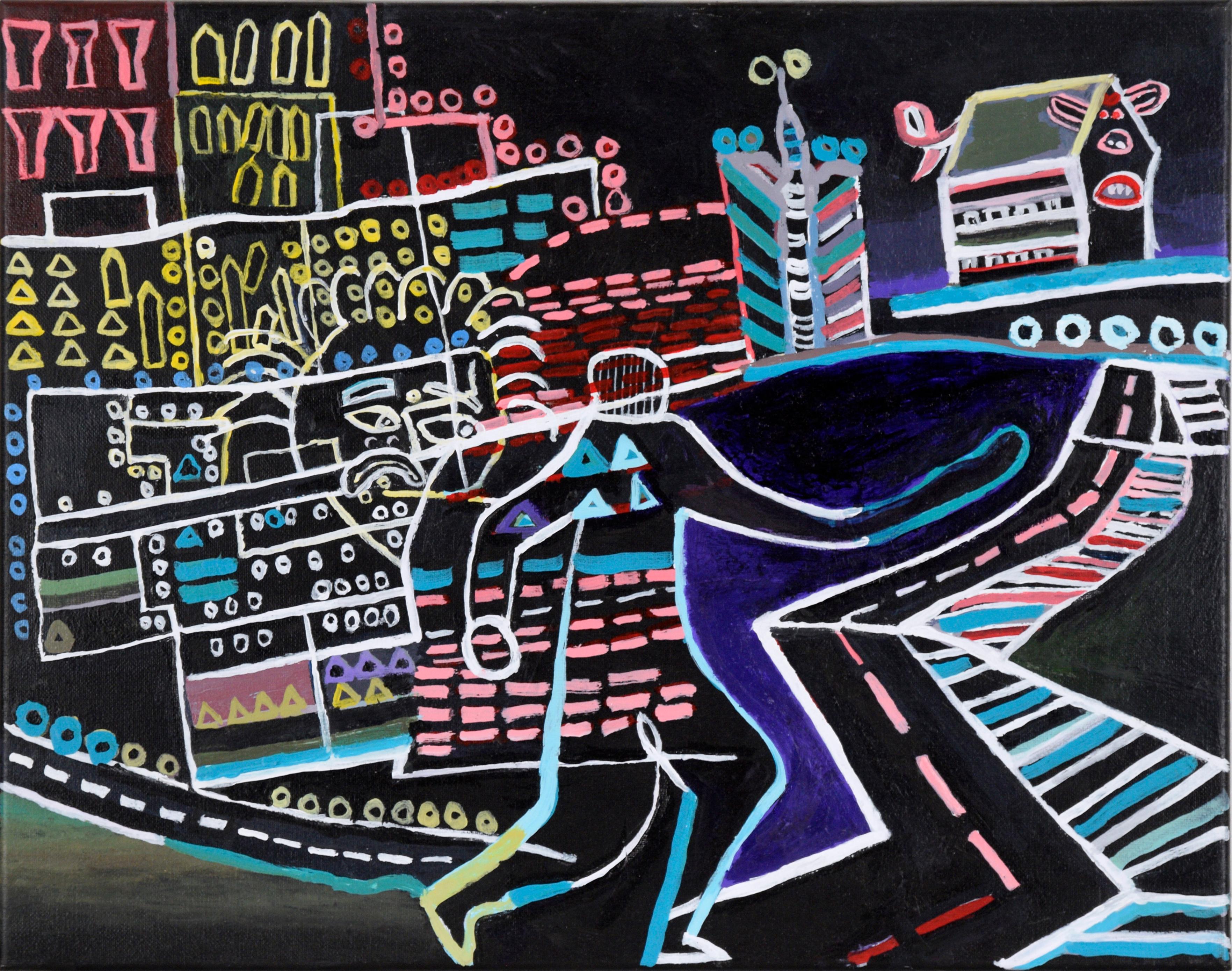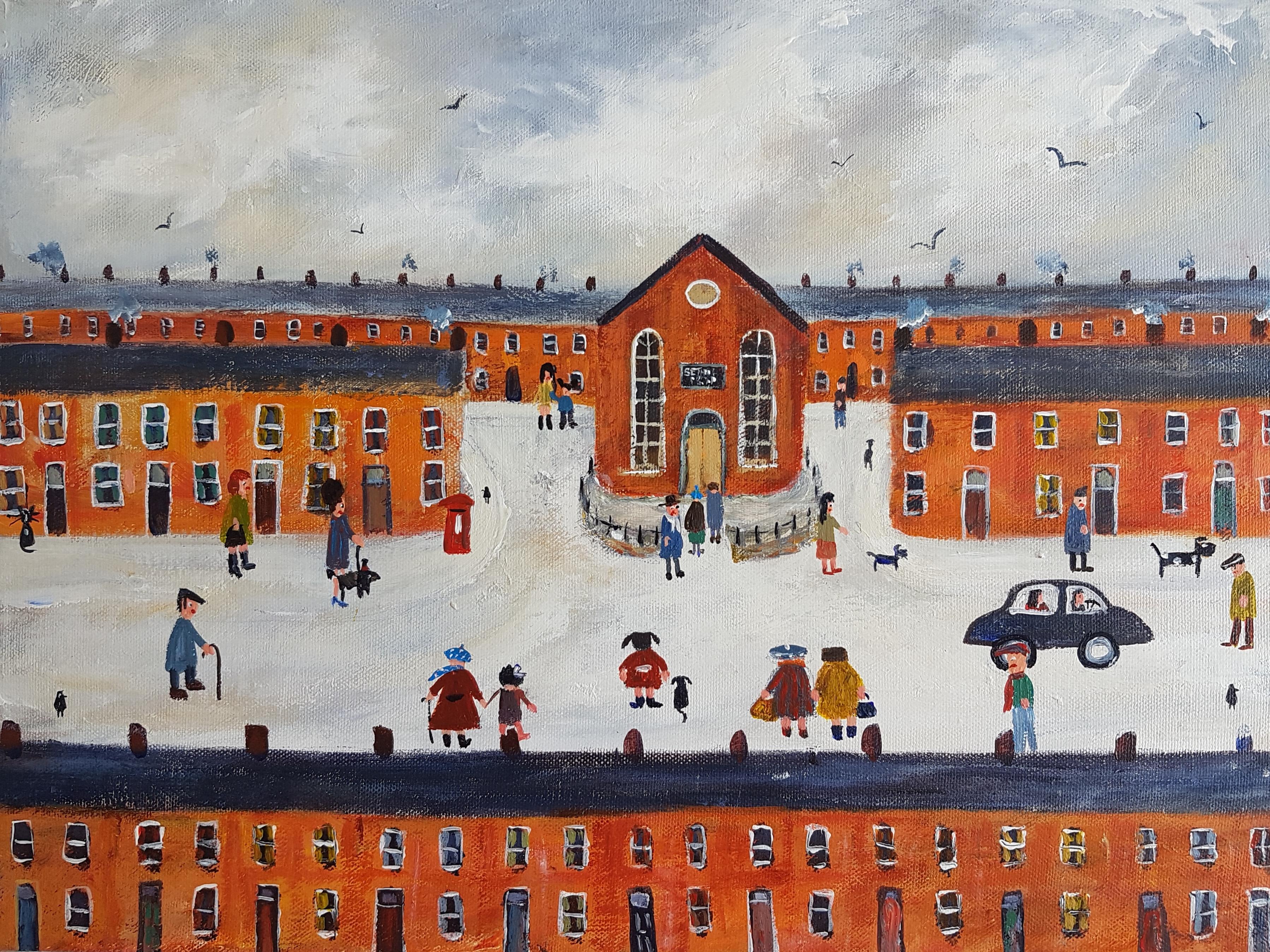Items Similar to I Know. Raquel Fariñas Acrylic Symbolic Colorful Landscape with figure Folk Art
Want more images or videos?
Request additional images or videos from the seller
1 of 13
Raquel FariñasI Know. Raquel Fariñas Acrylic Symbolic Colorful Landscape with figure Folk Art2021
2021
About the Item
"I Know" (Lo sé), Acrylic on canvas, H 50x W 40x D 2 cm.
The pictures of Raquel Fariñas are presented before our eyes with an almost naive simplicity. We find in them elements of nature reduced to their most synthetic features, primitive games of perspective, and geometric frames as agglutination of those elements dispersed by the painting in apparent chaos.
Her work is full of universal symbols belonging to the imaginary of traditional culture of all time; with them, and her masterful use of color and composition, she manages to unleash her deepest vital concerns.
Raquel Fariñas, Spanish artist, art designer, teacher and art therapist, is also a renowned illustrator of children´s literature.
As an art therapist, Raquel Fariñas uses her artistic creations as personal therapy, which helps her reflect on life and on her own existence, reducing highly complex thoughts to the most essential pictorial expression. The sun and the moon; the earth, the wind and the sea; plants and flowers; the fish, and the birds; the characters that fly chasing their dreams, sometimes so difficult to reach; and the world upside down are part of her pictorial universe.
Her paintings, of great chromatic beauty, are complex but harmonious compositions that convey goodness and serenity. The calm that is reached after effective art therapy.
The artist says:
“My paintings are the medium that I dispose off to reflect on the reality beyond rational knowledge, to portray the beauty I always seek. When I paint, every element of the reality I am depicting is revealed as a carrier of truth and beauty, which confers them a different sense than its mere appearance or utility.
At this conceptual plane, everything is interrelated and I notice another existence that I’m unable to explain with words the foundations of life’. So, what I can not express in concept, I do it with images, and it is here where the world of symbols appears; the concepts of unveiling and hiding are connected in a symbol. Symbols, myths, dreams reveal what escapes from immediate experience, to consciousness.
This is how I create shapes in my art work. In a tree I find the Natural Law of Development and Growth. In the circular, round, the Cyclical Law of the Sun and the Moon, and their celestial movements; the cycles of food, and water… Also the fabrics are important: everything is weaved, linked.
There is no opposition between up and down, The one is reflection of the other.
To see and to contemplate is not the same. When I paint I attempt to contemplate, and I give this contemplation to other people, who will transform my signs in symbols and my symbols in signs. I never ask to follow my interpretations. You, the viewer, are the creator of a new meaning”.
RAQUEL FARIÑAS
***The Spanish Philatelic Postal and Telegraphic Service issued a beautiful series of eight self-adhesive stamp depicting reproductions of eight works by Raquel Fariñas which have Spanish Traditional Nursery Rhymes as a common theme, as well as a stamp from one of her paintings to commemorate Christmas 2003.
- Creator:Raquel Fariñas (1964, Spanish)
- Creation Year:2021
- Dimensions:Height: 19.69 in (50 cm)Width: 15.75 in (40 cm)Depth: 0.79 in (2 cm)
- Medium:
- Movement & Style:
- Period:
- Condition:
- Gallery Location:Segovia, ES
- Reference Number:1stDibs: LU74439336012
About the Seller
5.0
Vetted Seller
These experienced sellers undergo a comprehensive evaluation by our team of in-house experts.
Established in 2002
1stDibs seller since 2017
58 sales on 1stDibs
Typical response time: 4 hours
- ShippingRetrieving quote...Ships From: Segovia, Spain
- Return PolicyA return for this item may be initiated within 14 days of delivery.
More From This SellerView All
- Cemented. Raquel Fariñas Symbolic Grey-Blue Acrylic on panel Folk Art LandscapeBy Raquel FariñasLocated in Segovia, ES"Cemented". (Cimentada). Acrylic and mixed media on wood panel, 54x40x4 cm. The pictures of Raquel Fariñas are presented before our eyes with an almos...Category
2010s Folk Art Figurative Paintings
MaterialsMixed Media, Wood Panel, Acrylic
- In Paradise. Acrylic on canvas Raquel Fariñas Symbolic Folk Art LandscapeBy Raquel FariñasLocated in Segovia, ESIn paradise (En el paraíso). Acrylic, mixed media/wood panel. Dimension art cm.: H 90, W 60, D 6 cm. / Inches (H) 35.43 x (W) 23.62 x (D) 2.36 " The pictures of Raquel Fariñas...Category
Early 2000s Folk Art Figurative Paintings
MaterialsMixed Media, Acrylic, Wood Panel
- Another space is possible. Raquel Fariñas Symbolic Acrylic Folk Art LandscapeBy Raquel FariñasLocated in Segovia, ES"Another space is possible". (Otro espacio es posible), Acrylic and mixed media on Wood panel, 59.5x45 cm. The pictures of Raquel Fariñas are presented...Category
2010s Folk Art Figurative Paintings
MaterialsMixed Media, Acrylic, Wood Panel
- There are always other ways ... Raquel Fariñas Folk Art Symbolic LandscapeBy Raquel FariñasLocated in Segovia, ESThere are always other ways to arrive to the destination (Siempre hay otros medios de llegar al destino), acrylic an mixed media on wood panel. Dimension art cm.; (H) 47 x (W) 88.5 x (D) 5 / Inches: (H) 18.5 x (W) 34.84 x (D) 1.97 " The pictures of Raquel Fariñas...Category
2010s Folk Art Figurative Paintings
MaterialsMixed Media, Acrylic, Wood Panel
- A breath of fresh air. Symbolic Acrylic paint Folk Art Landscape with figureBy Raquel FariñasLocated in Segovia, ESA breath of fresh air (Un soplo de aire fresco). Symbolic acrylic paint on panel Colorful Folk Art Landscape with figure. Dimension art cm.: (H) 43 x (W) 53 x (D) 6 cm. The pictu...Category
2010s Folk Art Figurative Paintings
MaterialsMixed Media, Acrylic, Wood Panel
- If it was wind..., Raquel Fariñas Symbolic Blue Landscape with figures Folk ArtBy Raquel FariñasLocated in Segovia, ES"If it was wind, I would bathe in your breeze", symbolic figurative landscape with figures. Acrylic and mixed media on wood panel. Dimesions: (H) 44 x (W) 57 x (D) 5 cm. The picture...Category
Early 2000s Folk Art Figurative Paintings
MaterialsMixed Media, Acrylic, Wood Panel
You May Also Like
- Mother EarthBy Mohammad AriyaeiLocated in Paris, FRAcrylic paint on canvas Signed and entitled by the artistCategory
2010s Outsider Art Figurative Paintings
MaterialsCanvas, Acrylic
- Magic Realist Surrealist Latin American Naive Fantasy PaintingBy German Ramon Duron LanzaLocated in Surfside, FLMagic realist fantasy painting in the manner of Ernst Fuchs and Arik Brauer. Naïve art is any form of visual art that is created by a person who lacks the formal education and training that a professional artist undergoes (in anatomy, art history, technique, perspective, ways of seeing). Unlike folk art, naïve art does not necessarily evince a distinct cultural context or tradition. Naïve art is recognized, and often imitated, for its childlike simplicity and frankness. Paintings of this kind typically have a flat rendering style with a rudimentary expression of perspective. One particularly influential painter of "naïve art" was Henri Rousseau (1844–1910), a French Post-Impressionist who was discovered by Pablo Picasso. Naïve art is often seen as outsider art that is by someone without formal (or little) training or degree. While this was true before the twentieth century, there are now academies for naïve art. Naïve art is now a fully recognized art genre, represented in art galleries worldwide. Museums devoted to naïve art now exist in Kecskemét, Hungary; Riga, Latvia; Jaen, Spain; Rio de Janeiro, Brasil; Vicq France and Paris. "Primitive art" is another term often applied to art by those without formal training, but is historically more often applied to work from certain cultures that have been judged socially or technologically "primitive" by Western academia, such as Native American, sub saharan African or Pacific Island art (see Tribal art). This is distinguished from the self-conscious, "primitive" inspired movement primitivism. Another term related to (but not completely synonymous with) naïve art is folk art. There also exist the terms "naïvism" and "primitivism" which are usually applied to professional painters working in the style of naïve art (like Paul Gauguin, Mikhail Larionov, Paul Klee). At all events, naive art can be regarded as having occupied an "official" position in the annals of twentieth-century art since - at the very latest - the publication of the Der Blaue Reiter, an almanac in 1912. Wassily Kandinsky and Franz Marc, who brought out the almanac, presented 6 reproductions of paintings by le Douanier' Rousseau (Henri Rousseau), comparing them with other pictorial examples. However, most experts agree that the year that naive art was "discovered" was 1885, when the painter Paul Signac became aware of the talents of Henri Rousseau and set about organizing exhibitions of his work in a number of prestigious galleries. The Earth Group (Grupa Zemlja) were Croatian artists, architects and intellectuals active in Zagreb from 1929 to 1935. The group included the painters Krsto Hegedušić, Edo Kovačević, Omer Mujadžić, Kamilo Ružička, Ivan Tabaković, and Oton Postružnik, the sculptors Antun Augustinčić, Frano Kršinić, and the architect Drago Ibler. A term applied to Yugoslav (Croatian) naive painters working in or around the village of Hlebine, near the Hungarian border, from about 1930. Some of the best known naive artists are Dragan Gaži, Ivan Generalić, Josip Generalić, Krsto Hegedušić, Mijo Kovačić, Ivan Lacković-Croata, Franjo Mraz, Ivan Večenaj and Mirko Virius. Camille Bombois (1883–1970) Ferdinand Cheval, known as 'le facteur Cheval' (1836–1924) Henry Darger (1892–1973) L. S. Lowry (1887–1976) Grandma Moses, Anna Mary Robertson (1860–1961) Nikifor (1895–1968) Poland, Horace Pippin (1888–1946) Jon Serl (1894-1993) United States Alfred Wallis (1855–1942) Scottie Wilson (1890–1972) Gesner Abelard (b. 1922) Jan Balet (1913–2009) Michel Delacroix (b. 1933) France Howard Finster (1916–2001) Ivan Rabuzin (1921–2008) Spontaneous Art Museum in Brussels Art en Marge Museum in Brussels MADmusée in Liege International Museum of Naive Art of Brazil in Cosme Velho, Rio de Janeiro Gallery Jacques Ardies in São Paulo Musée international d'art naïf de Magog in Magog Croatian Museum of Naïve Art in Zagreb Gallery of Croatian Naïve Art...Category
20th Century Folk Art Figurative Paintings
MaterialsCanvas, Acrylic
- "Abandoned by My Family in Chicago" Outsider Art in Acrylic on CanvasLocated in Soquel, CASurreal depiction of a figure walking though a city by Marshall Woodall (American, b. 1958). The cityscape is represented in outlines only, creating the impression of being lit up in neon lights at night. The figure walking through the scene is an outline, reminiscent of a walk sign. Throughout the piece, there are hidden faces in the buildings. Signed, dated, and titled on verso along the stretcher: Marshall Woodall Aug 12/2019 'Abandoned by my family in Chicago' Unframed, but the edges are painted for a frame-less display. Canvas size: 16"H x 20"W Marshall Woodall (b. 1958) was born in Oklahoma City, OK. Woodall’s fascination with art began at an early age. His life has been a journey into self-expression and storytelling through music, drawing, and painting. ‘‘I am off the wall and have an unusual imagination. I think about things that people don’t always think about or notice.’’ Self-taught but inspired by Gary Larson...Category
2010s Outsider Art Figurative Paintings
MaterialsCanvas, Acrylic
- Sunday Song, Naive School PaintingBy Therese JamesLocated in Brecon, PowysTraditions are important in Wales. This painting from Therese takes a peek at the Sunday morning outing to chapel. Wearing their Sunday best the villagers head out and catch up on al...Category
21st Century and Contemporary Outsider Art Landscape Paintings
MaterialsAcrylic, Canvas
- Blowing The Cobwebs Away. Contemporary Figurative PaintingBy Therese JamesLocated in Brecon, PowysAcrylic on canvas, signed and framedCategory
2010s Outsider Art Figurative Paintings
MaterialsAcrylic, Canvas
- The Moment We Knew. Contemporary Figurative PaintingBy Therese JamesLocated in Brecon, PowysAcrylic on canvas, signed and framed Image 16" x 16". Framed 18" x 18"Category
2010s Outsider Art Figurative Paintings
MaterialsAcrylic, Canvas





